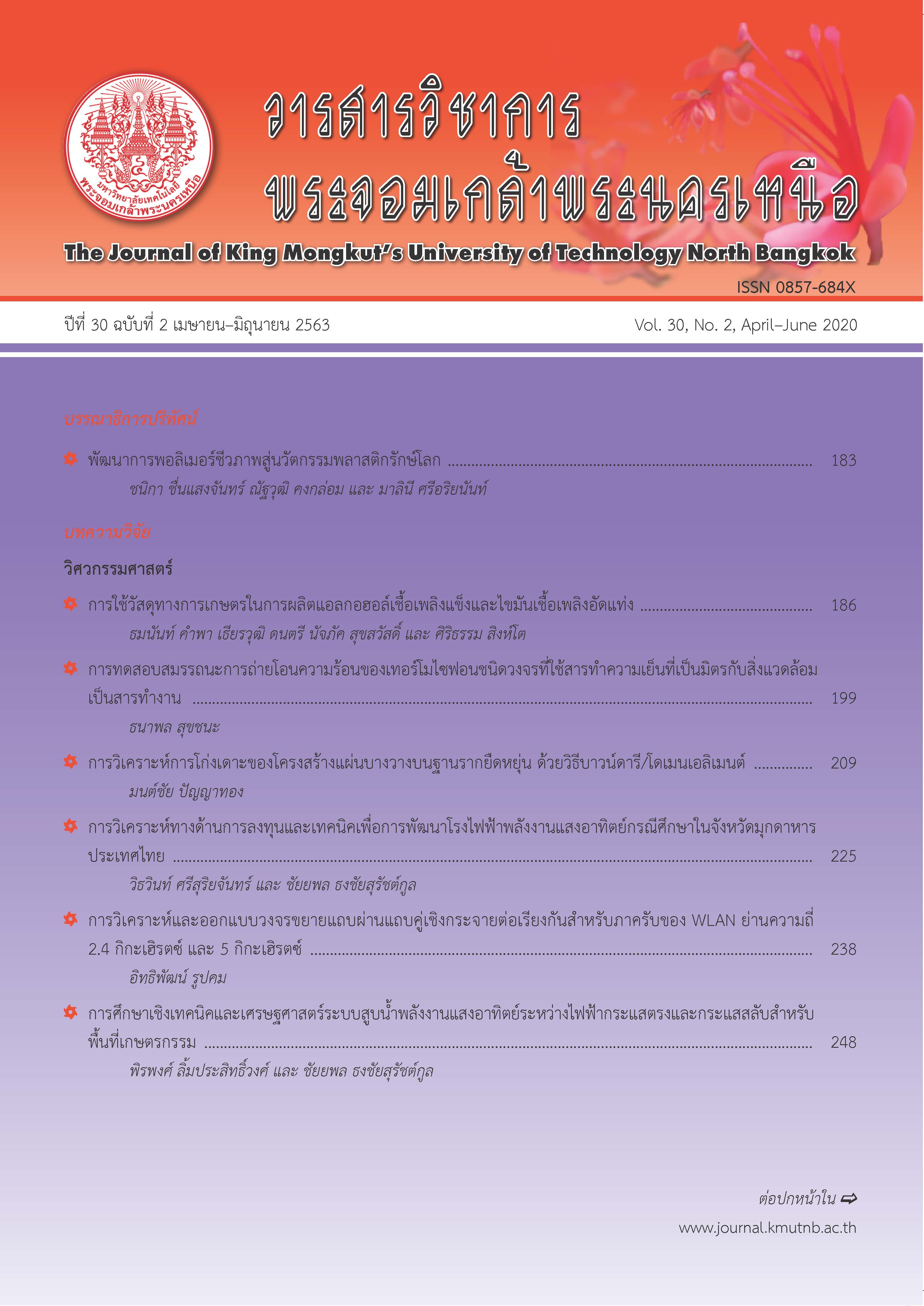การศึกษาเชิงเทคนิคและเศรษฐศาสตร์ระบบสูบน้ำพลังงานแสงอาทิตย์ระหว่างไฟฟ้ากระแสตรงและกระแสสลับสำหรับพื้นที่เกษตรกรรม
Main Article Content
บทคัดย่อ
งานวิจัยนี้นำเสนอการศึกษาเครื่องสูบน้ำพลังงานแสงอาทิตย์แบบไฟฟ้ากระแสตรง (DC) และไฟฟ้ากระแสสลับ (AC) สำหรับพื้นที่เกษตรกรรม งานวิจัยได้ทำการวิเคราะห์ทั้งทางด้านเทคนิคและด้านเศรษฐศาสตร์ หรือความคุ้มค่าในการลงทุน ซึ่งจะทำให้ได้แนวทางที่เหมาะสมในการนำไปใช้งานในสถานการณ์อื่นได้ ระบบเครื่องสูบน้ำพลังงานแสงอาทิตย์แบบไฟฟ้ากระแสตรง ประกอบไปด้วยแผงเซลล์แสงอาทิตย์ 40 โวลต์ 325 วัตต์ จำนวน 5 แผง ต่ออนุกรมกันเป็นชุดเพื่อจ่ายแรงดันไฟฟ้ากระแสตรงให้กับมอเตอร์ไฟฟ้ากระแสตรง 50–200 โวลต์ และระบบเครื่องสูบน้ำพลังงานแสงอาทิตย์แบบไฟฟ้ากระแสสลับ ประกอบไปด้วยแผงเซลล์แสงอาทิตย์ 325 วัตต์ ต่ออนุกรมจำนวน 10 แผง โดยจ่ายแรงดันไฟฟ้ากระแสตรงผ่านอินเวอร์เตอร์เชิงพาณิชย์ขนาด 3.0 กิโลวัตต์ เพื่อจ่ายแรงดันไฟฟ้ากระแสสลับให้กับมอเตอร์ไฟฟ้ากระแสสลับชนิดเหนี่ยวนำ 3 เฟส 2.2 กิโลวัตต์ (3 แรงม้า) ซึ่งได้เชื่อมต่อโดยตรงกับปั๊มชนิดหอยโข่ง ปัจจัยเปรียบเทียบ ได้แก่ ต้นทุน การลงทุน การก่อสร้างรูปแบบการจ่ายน้ำและปริมาณน้ำ จากผลการวิจัยพบว่า ระบบเครื่องสูบน้ำแบบกระแสตรงมีต้นทุนการลงทุนต่ำกว่าระบบเครื่องสูบน้ำแบบกระแสสลับเปรียบเทียบในปริมาณน้ำเท่ากัน หากเปรียบเทียบในเชิงเศรษฐศาสตร์ระหว่างระบบเครื่องสูบน้ำพลังงานแสงอาทิตย์ชนิดแบบไฟฟ้ากระแสตรงประเมินผลตอบแทนการลงทุน และระยะเวลาคุ้มค่าการลงทุน เมื่อเทียบกับเครื่องสูบน้ำชนิดเครื่องยนต์เบนซิน จะได้ผลตอบแทนการลงทุนประมาณร้อยละ 27.48 ต่อปี หรือคิดเป็นระยะเวลาคุ้มค่าการลงทุนประมาณ 3.64 ต่อปี ทั้งนี้ ขึ้นอยู่กับประมาณการชั่วโมงการทำงานต่อปี นอกจากนี้ระบบกระแสสลับยังสามารถพัฒนาเป็นระบบไฮบริด กล่าวอีกนัยหนึ่งคือสามารถนำไฟฟ้ากระแสสลับจากการไฟฟ้าจ่ายเพิ่มเข้าโดยตรงที่ชุดอินเวอร์เตอร์โดยไม่จำเป็นต้องมีอุปกรณ์เพิ่มเติม แต่ในทางกลับกันระบบเครื่องสูบน้ำแบบกระแสตรง นั้นมีความซับซ้อนน้อย และง่ายกว่ากล่าวโดยสรุประบบเครื่องสูบน้ำแบบกระแสตรงขนาดเล็ก เหมาะสำหรับพื้นที่เกษตรกรรมขนาดพื้นที่ไม่ห่างไกลจากแหล่งน้ำมากนัก และในขณะที่ระบบเครื่องสูบน้ำกระแสสลับนั้นเหมาะสำหรับความต้องการอัตราการไหลสูงและแรงดันสูง สามารถออกแบบให้เหมาะกับพื้นที่เกษตรกรรมขนาดใหญ่ หรือขึ้นเนิน หรือระยะทางไกลจากแหล่งน้ำได้
Article Details
บทความที่ลงตีพิมพ์เป็นข้อคิดเห็นของผู้เขียนเท่านั้น
ผู้เขียนจะต้องเป็นผู้รับผิดชอบต่อผลทางกฎหมายใดๆ ที่อาจเกิดขึ้นจากบทความนั้น
เอกสารอ้างอิง
[2] Department of Agricultural Extension. (2018, February). Occupation of population survey. Office of Agricultural Economics. Bangkok, Thailand [Online]. Available: http://www.agriinfo.doae.go.th/5year/general/54-58/farmer54-58.pdf
[3] Statistics of land whole kingdom. (2018, Mac.). Ministry of Agriculture and Cooperatives. Office of Agricultural Economics. Bangkok, Thailand [Online]. Available: http://www.agriinfo.doae.go.th /year60/general/land/land60.pdf
[4] J. Charlie and P. Paitoon, “Thailand 4.0 and the fourth industrial revolution,” Asian International Journal of Social Sciences, vol. 17, no. 1, pp. 4–35, 2017.
[5] S. Manish, K. Mamta, and K. Vikas, “Automatic humidity monitoring and pumping system for farmers,” International Journal of Development Research, vol. 6, no. 4, pp. 7446–7452, 2016.
[6] Department of Alternative Energy Development and Efficiency Thailand, “Research and development in the field of renewable energy,” Bangkok, Thailand, 2012.
[7] Department of Alternative Energy Development and Efficiency. (2018, Nov.). Areas with solar power potential. Ministry of Energy. Bangkok, Thailand [Online]. Available: http://weben.dede.go.th/webmax/content/areas-solar-powerpotential
[8] S. Rapeepat, “The use of solar energy to reduce energy use in agricultural areas that doesn’t have access to electricity,” NDC Security Review, Thailand National Defence College, Bangkok, Thailand, 2017.
[9] Global solar Atlas.(2019, April). Map info Global Horizontal irradiation. The World Bank Group. [Online]. Available: https://globalsolaratlas.in fo/?s=16.53833,104.715&m=sg:ghi&e=1
[10] A. phowan, P. Sriphadungtham, A. Limmanee, and E. Hattha, “Performance analysis of polycrystalline silicon and thin film amorphous silicon solar cells installed in Thailand by using simulation software,” in Proceedings the 8th Electrical Engineering / Electronics, Computer, Telecommunications and Information Technology (ECTI), 2011, pp. 625–628 (in Thai).
[11] M. Kaur and H. Singh, “A Review: Comparison of silicon solar cells and thin film solar cells,” International Journal of Core Engineering & Management, vol. 3, no. 2, pp. 15–23, 2016.
[12] M. N. Imamzai, M. Aghaei, Y. Hanum, M. D. Thayoob, and M. Forouzanfar, “A review on comparison between traditional silicon solar cells and thinfilm cdte solar cells,” in Proceedings National Graduate Conference 2012 (natgrad2012), University Tenaga National, Putrajaya Campus, 2012, pp. 1–5.
[13] C. Kalu, E. Isaac, and U. Mfonobong Anthony, “Comparative study of performance of three different photovoltaic technologies,” Mathematical and Software Engineering, vol. 2, no. 1, pp. 19–29, 2016.
[14] Google map. (2019, Jan.). Experimental location. Google [Online]. Available: https://goo.gl/maps/Ra48JnV6ZELGef9U6
[15] Department of Alternative Energy Development and Efficiency. (2018, Nov.). Areas with solar power potential. Ministry of Energy. Bangkok, Thailand [Online]. Available: http://weben.dede.go.th/webmax/content/undercontruction
[16] MEATH Super Pump. (2019, Oct.). WCM-Series Medium head centrifugal pump. Mitsubishi Electric Automation (Thailand). Bangkok, Thailand [Online]. Available: https://www.meath-co.com/web/es-mit/UploadFile/WCM.pdf
[17] GCL System Integration Technology. (2018, Oct.). Technical data and Specification of “GCLP6/72325” PV solar panel 325 PV module. GCL Energy Center. Jiangsu, Suzhou [Online]. Available: www.gclsi.com/en
[18] Tinamics (2015, Oct.). Solar pump using SINAMICS V20, Tinamics. Bangkok, Thailand [Online]. Available: http://tinamics.com/download/tinamics_com/solar-v20-vfd.pdf
[19] HONDA ENGINE (2019, October). GP 160 gasoline (petrol) engine. HONDA [Online]. Available: www.honda-engine.com
[20] L. Pirapong and T. Chaiyapon, “A commercial inverter applying for solar pump in agriculture plant case study in south of Thailand,” in Proceedings of the 2018 International Conference on Robotics, Control and Automation Engineering, ijing, China, 2018, pp. 1–4.
[21] Wikipedia. (2019, Feb.). The affinity laws for pumps. [Online]. Available: https://en.wikipedia.org/wiki/Affinity_laws
[22] M. Z. Jacobson and V. Jadhav, “World estimates of PV optimal tilt angles and ratios of sunlight incident upon tilted and tracked PV panels relative to horizontal panels,” Solar Energy, vol. 169, pp. 55–56, 2018.

